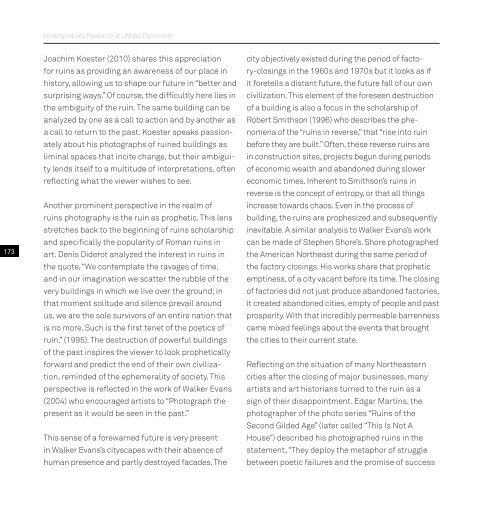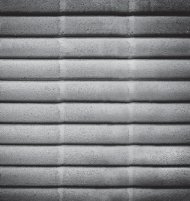Undergrad_Book_16-18_Pge_View_Print_no print marks_compressed
Create successful ePaper yourself
Turn your PDF publications into a flip-book with our unique Google optimized e-Paper software.
<strong>Undergrad</strong>uate Research at UMass Dartmouth<br />
173<br />
Joachim Koester (2010) shares this appreciation<br />
for ruins as providing an awareness of our place in<br />
history, allowing us to shape our future in “better and<br />
surprising ways.” Of course, the difficultly here lies in<br />
the ambiguity of the ruin. The same building can be<br />
analyzed by one as a call to action and by a<strong>no</strong>ther as<br />
a call to return to the past. Koester speaks passionately<br />
about his photographs of ruined buildings as<br />
liminal spaces that incite change, but their ambiguity<br />
lends itself to a multitude of interpretations, often<br />
reflecting what the viewer wishes to see.<br />
A<strong>no</strong>ther prominent perspective in the realm of<br />
ruins photography is the ruin as prophetic. This lens<br />
stretches back to the beginning of ruins scholarship<br />
and specifically the popularity of Roman ruins in<br />
art. Denis Diderot analyzed the interest in ruins in<br />
the quote, “We contemplate the ravages of time,<br />
and in our imagination we scatter the rubble of the<br />
very buildings in which we live over the ground; in<br />
that moment solitude and silence prevail around<br />
us, we are the sole survivors of an entire nation that<br />
is <strong>no</strong> more. Such is the first tenet of the poetics of<br />
ruin.” (1995). The destruction of powerful buildings<br />
of the past inspires the viewer to look prophetically<br />
forward and predict the end of their own civilization,<br />
reminded of the ephemerality of society. This<br />
perspective is reflected in the work of Walker Evans<br />
(2004) who encouraged artists to “Photograph the<br />
present as it would be seen in the past.”<br />
This sense of a forewarned future is very present<br />
in Walker Evans’s cityscapes with their absence of<br />
human presence and partly destroyed facades. The<br />
city objectively existed during the period of factory-closings<br />
in the 1960s and 1970s but it looks as if<br />
it foretells a distant future, the future fall of our own<br />
civilization. This element of the foreseen destruction<br />
of a building is also a focus in the scholarship of<br />
Robert Smithson (1996) who describes the phe<strong>no</strong>mena<br />
of the “ruins in reverse,” that “rise into ruin<br />
before they are built.” Often, these reverse ruins are<br />
in construction sites, projects begun during periods<br />
of eco<strong>no</strong>mic wealth and abandoned during slower<br />
eco<strong>no</strong>mic times. Inherent to Smithson’s ruins in<br />
reverse is the concept of entropy, or that all things<br />
increase towards chaos. Even in the process of<br />
building, the ruins are prophesized and subsequently<br />
inevitable. A similar analysis to Walker Evans’s work<br />
can be made of Stephen Shore’s. Shore photographed<br />
the American Northeast during the same period of<br />
the factory closings. His works share that prophetic<br />
emptiness, of a city vacant before its time. The closing<br />
of factories did <strong>no</strong>t just produce abandoned factories,<br />
it created abandoned cities, empty of people and past<br />
prosperity. With that incredibly permeable barrenness<br />
came mixed feelings about the events that brought<br />
the cities to their current state.<br />
Reflecting on the situation of many Northeastern<br />
cities after the closing of major businesses, many<br />
artists and art historians turned to the ruin as a<br />
sign of their disappointment. Edgar Martins, the<br />
photographer of the photo series “Ruins of the<br />
Second Gilded Age” (later called “This Is Not A<br />
House”) described his photographed ruins in the<br />
statement, “They deploy the metaphor of struggle<br />
between poetic failures and the promise of success



